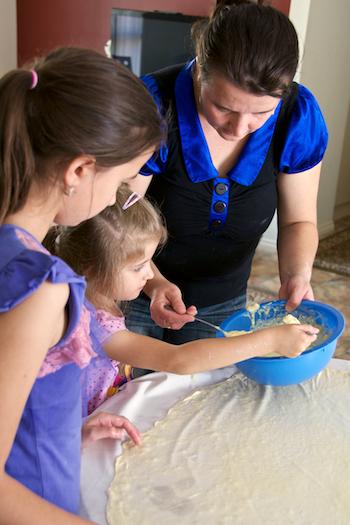Cooking together
Duration/age

Your child can learn a lot when cooking with you. Start with a family favourite that you all like to eat.
Talk about what you are going to make and what you will need. Ask your child to help you find the different utensils you need for cooking.
We are making pita. We need to find the sieve for the flour, a large bowl for mixing, and a cup for measuring out the flour.
Once you have all the utensils and ingredients, talk with your child about what will happen.
Let’s measure out all the dry ingredients first. Later we will add the liquid to make a firm dough.
Once you have finished mixing, pouring and filling, talk about what will happen next. Does the food need to be cooked in a hot oven? Or will it set in a cold fridge? Can you eat it straight away? Or is there more to do after it has finished cooking in the oven?
We need to roll out the dough as thin as we can before we add the cheese filling along the edge.
Once the cakes are cooked in the oven, we can ice them. The cakes need to be cool before we put the icing on top. We don’t want the icing to slide down the sides.
Materials you will need
- Ingredients
- Cooking utensils
- A recipe
Skills this activity improves
Why does this matter?
When your child helps you to cook and prepare food they are learning to quantify, compare and follow instructions. As your child listens to the instructions they are learning to follow directions and to predict the order and sequence something will happen in.
As they make their creations they are exploring time, quantity, space and size. These are all forms of measurement.
There are many words to do with cooking and baking. When you talk with your child as they cook they are learning new words and how to use the words to describe what they see and do.
What does this lead to?
Cooking helps your child to develop hand dominance, wrist rotation and strength in their hands. Hand dominance and strength is needed when children write or cut out curved shapes or objects.
Making, mixing and pouring helps children to understand that there are different ways we can measure and compare things. When we compare objects we can compare them by number, size, shape, volume, temperature, time or function.
The development of good listening skills is important for following directions and for conveying information to other people. If children do not listen carefully when they are given information they might go to the wrong place, not be sure of what they need to do, or give the wrong information to someone.
Language to use
- Mix, pour, stir, scoop, scrape, measure, roll
- Recipe, instructions
- Time, temperature, oven
- Hot, cold, frozen, warm, cool
- Soft, hard, liquid
- Bowl, spoon, rolling pin, oven, fridge, measuring cup, sieve
- Thick, thin, long, short
Questions to use
- Does this go in the oven or the fridge?
- How long will it take to cook?
- What could we use to measure if we didn't have a cup?
- Can you put the liquid in before the dry ingredients?
Useful tips
- If younger children are helping, use larger utensils that are easier for them to hold.
- Younger children can't concentrate as long as older children. If a younger child is helping, pick something quick and simple.
- Children love to help cook food for special events like birthdays and celebrations.
- You might also like to take a look at the activities Making pancakes and A freckle here, a sprinkle there.
- Remember to talk to your child in your home language.
More ideas
- Make a family recipe book.
- Set up a cooking area outside where your child can use things they have collected around the yard.
- Take photos as you cook together and use them to make a story book.
Variation by age
Birth to two year olds
- Set up a measuring tub with sand and containers in all different shapes and sizes.
- Set up a measuring table with scales.
- Create a cooking play box with plastic fruit for a rainy day.
- Add cooking utensils to the playdough. Can you make playdough chocolate cakes?
Three to five year olds
- Set up a measuring tub with sand and containers in all different shapes and sizes.
- Set up a measuring table with scales.
- Write an invitation to a special friend or family member to ask them to come and share the food.
- Add cooking utensils to the playdough. Can you make playdough chocolate cakes?
Questions to ask
- Which one is bigger? Which one is smaller?
- Can you fit more in?
- Where will we put the cake to cook?
Questions to ask
- Do they weigh the same?
- How many cups does it take to fill the big bucket?
- Who can we invite to come for tea?
- Are you making one big cake or lots of small cakes?
- How many cakes will we need to make for all the family?
Language to use
- Mix, pour, stir, scoop, scrape, measure, roll
- Bowl, spoon, rolling pin, oven, fridge, measuring cup, sieve
- Thick, thin, long, short
- Full, empty, half
- More, less, enough
- Heavy, light
Language to use
- Mix, pour, stir, scoop, scrape, measure, roll
- Bowl, spoon, rolling pin, oven, fridge, measuring cup, sieve
- Thick, thin, long, short
- Full, empty, half
- More, less, enough
- Heavy, light


